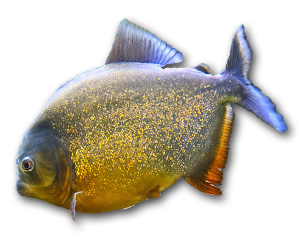Red Bellied Piranha

Quick Stats
| Size | 12" (30cm) |
|---|---|
| Tank | 200 litres + for a small school |
| Swimming Area | Bottom, middle |
| Ph | 6.0 to 7.5 |
| Temperature | 75ºF to 84ºF (24-29°C) |
| Food | Fish, lean meat and beef heart |
Common Name:
Red Bellied Piranha
Distribution:
South America, Widely distributed throughout the Amazon and Orinoco river basins.
Colouration:
The color can vary depending on location and age. The sides are pale Brown to slightly Olive. Some of the small scales can produce an intense Golden Yellow reflection. The body can have some variable dark markings across it in no particular pattern. The back is Blue- Gray to Brownish and the throat and belly areas are blood Red in healthy specimens. The Ventral, Pectoral and Anal fins are also bright Red. The Caudal and Dorsal fins are gray.
Lifespan:
20 years +
Maintenance:
20 to 30% weekly water changes. Reds are relatively easy to keep as long as you provide a big enough tank. They should be kept in groups of 3 fish upwards depending on the size of the tank. These are not a community fish and any fish put into their tank will eventually become food. Regular water changes and gravel vacuuming are essential for these guys as they are very messy eaters. Piranha are generally shy, nervous fish, and not the bloodthirsty maneaters they are made out to be. Even so, care is required when performing maintenance on their home. The best way to clean their tank is to turn the lights off. Try to avoid putting your hands into the tank. Using tongs to move objects in their tanks is the best option. Never use a net to catch them as they will easily chew through it. The best way to catch them is to place a bucket in the tank and coax them into it using a net. Their teethare extremely sharp and can do major damage if bitten. They will also attack each other and nip fins aswell. They can heal miraculously fast when cut or bitten.
Feeding:
Will accept most whole fish fillets (cod, salmon, hake) also prawns, whitebait, mussels, squid. Can be fed red meat as a rare treat (once a month max). Do not feed live food to your Piranha, as this can introduce diseases that may be carried by the live prey.
Substrate:
Sand.
Tank Decor:
The tank should be very large with live or plastic plants and also lots of swimming areas. Try to place hiding places for them as well. Placing plants or other pieces of decor at either end of the tank should deter them from darting through the side of the tank when startled. Driftwood is also a good addition to the tank as it buffers the pH to replicates their natural conditions.
Filtration:
Filtration is very important as these fish are messy eaters and do produce a lot of waste. It is also an idea to add a powerhead to create a current for them to swim in.
Biotype:
Murky waters of the Amazon and Orinoco Rivers.
Breeding:
Has been achieved in captivity, but requires a large tank, with good water quality and a good size group. These fish are egg layers and will stay with the nest and guard the eggs. They give no parental care however and it is best to remove the parents or eggs to another tank. Fry are very fast growing and should be fed on freshly hatched brine shrimp. They should then be fed on standard flake food for as long as they will accept it. Baby Piranha are very cannabilistic and should be fed about four times a day to minimize this.